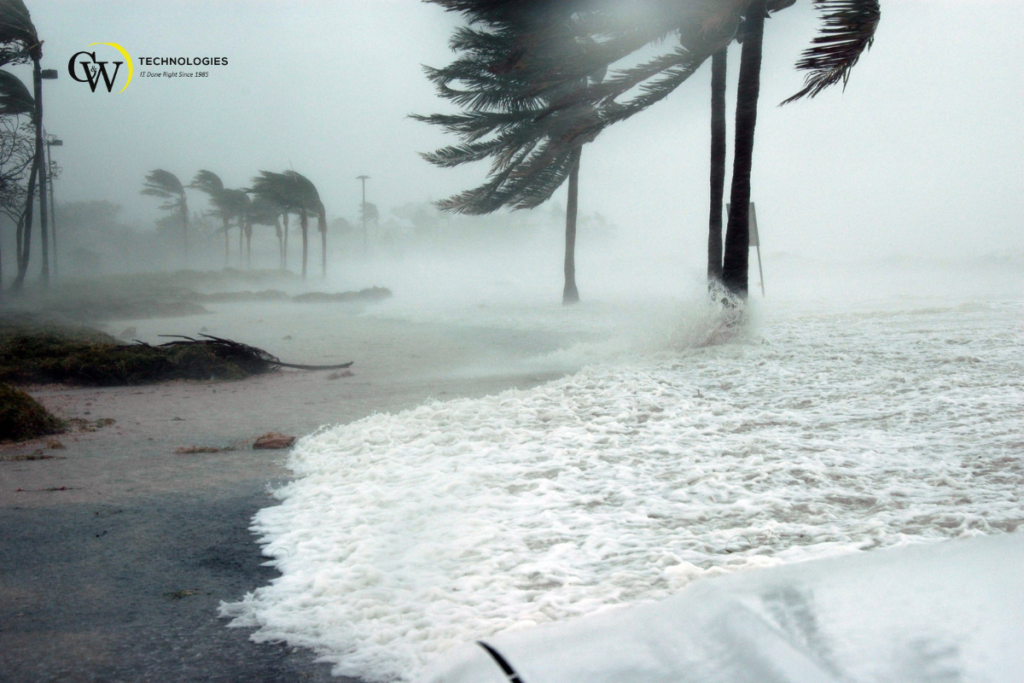Many prepare their storm shutters, first aid kit, evacuation routes, supplies, loose items and hurricane preparation checklist for this time of year. While these are all crucial steps to take to successfully master hurricane season, the safety of your technology is just as critical as any other preparation. Protecting your digital assets and ensuring business continuity requires a proactive approach. Since hurricane season is amongst us, this guide is set in place to walk you through essential steps to prepare and safeguard your technology from the fury of a hurricane.
Understanding the Threat: How Hurricanes Affect Technology
Hurricanes bring high winds, heavy rain, and flood damage, all of which can severely damage technology infrastructure. Power surges and outages also pose significant risks to electrical equipment and supplies. As these dangerous storms can cause a disaster, preparing your technology ahead of time can mean the difference between minimal disruption and significant loss. Below are some of the ways storms can affect technology:
- Power Outages: Rain and wind can cause power outages, which can lead to data loss and equipment damage.
- Water Damage: Flooding is a major concern during hurricanes, as water damage can destroy electronic devices and cause corrosion. Cover any personal items with plastic sheeting.
- Internet/Communication Disruption: High-speed winds and fallen trees or debris may disrupt internet and communication services. If able, bring inside loose items and secure other means of personal property.
- Physical Damage: High winds and flying debris from hurricane-force winds can physically damage buildings, windows, gutters and rooftops, putting technology and property infrastructures at risk.
It is essential to understand the threats of a severe storm so you can take the necessary precautions to protect your technology.
Who is Affected by Hurricanes
Coastal individuals and businesses are highly vulnerable to storm impacts, particularly those reliant on digital operations. It’s crucial to understand and protect technology infrastructure from potential storm damage. The next section offers a hurricane preparation checklist and tips to protect your technology.
Key Considerations for Technology Preparedness: Hurricane Preparation Checklist
- Data Backup: Securely back up all critical data in an off-site location.
- Physical Protection: Elevate hardware above potential flood levels and shield it from water damage. Unplug and put technology safely in waterproof cases. Store your technology in a secure and safe place.
- Surge Protection: Use surge protectors and uninterruptible power supplies (UPS) for defense in case you were to lose power.
- Continuity Planning: Develop and test a comprehensive business continuity plan focusing on technology recovery.
- Employee Training: Ensure staff is trained on emergency technology protocols, including remote work options in case of emergencies.
- Communication: Establish reliable communication channels with employees, clients, and vendors.
- Inventory Management: Maintain an up-to-date inventory of technology equipment, including serial numbers and warranties.
- Stay Informed: Monitor hurricane developments and evacuation orders to make timely technology protection decisions.
During the Hurricane
Communication Plans
Keep open lines of communication with your team and stakeholders. Use email, messaging, or phone calls to provide updates and instructions.
Technology Shutdown and Protection Decisions
Decide when to shut down non-essential systems to prevent damage. Ensure critical systems are protected and powered as long as it’s safe.
Staying Informed
Monitor weather reports and updates from local authorities to make informed decisions.
After the Hurricane
Assessing Technology Damage
Once it’s safe, inspect your technology and review important documents for any damage. Document damages for insurance purposes and begin necessary repairs or replacements.
Implementing Recovery Strategies
Activate your business continuity plan and adjust as needed based on the situation. Focus on restoring critical systems first.
Rebuilding and Moving Forward
Learn from the experience to enhance future preparedness. Update your plans and strategies to better protect your technology next time.
Community Support and Collaboration
Partnering with local businesses and community groups can be crucial for technology recovery after a hurricane. Join networks offering support and resources to speed up recovery. Sharing expertise and resources like workspace or technology helps all parties recover faster.
Leveraging Technology for Community Benefit
Consider how technology can help in business recovery and support the community. Provide tech support or digital resources to relief efforts, or partner with local aid organizations to enhance recovery through technology. By actively supporting the community, businesses can foster goodwill and build resilience against future disasters.
Strengthening Future Preparedness
To build a resilient technology infrastructure, assess what worked during the hurricane and what needs improvement. Update your plans with these insights and ensure all team members are informed of changes. Investing in advanced protective technology, like cloud-based systems, can enhance your ability to withstand future hurricane challenges and prepare for storms.
What to Do if Your Technology is Affected by the Hurricane – What is Your Hurricane Preparation Checklist?
Immediate Actions
- Safety First: Ensure the area is safe for you and your team before entering. Check for any hazards such as structural damage, flooding, or electrical issues.
- Disconnect Power: If the area is safe to access, disconnect any affected technology from power sources to prevent further electrical damage or accidents.
- Assessment: Perform a thorough inspection of your technology for visible damage. Look for water exposure, physical damage, or any immediate repair needs.
Data Recovery
- Data Backups: Use your off-site backup to assess the extent of data loss. If backups are damaged or inaccessible, consider seeking professional data recovery services.
- Contact IT Support: Reach out to IT professionals for support in restoring lost data and addressing any system challenges caused by the hurricane.
Repair and Replace
- Evaluate Equipment: Determine which devices can be repaired and which need replacement.
- Warranty and Insurance: Review warranties and insurance policies to facilitate the repair or replacement process. Document all damages with photos and detailed descriptions for claims.
Understanding Storm Surge
Storm surge, a major threat during hurricanes, causes severe coastal damage and flooding as strong winds push seawater onto land. Its severity varies based on storm intensity, speed, coastline shape, and tides. Preparing for storm surges is vital, including heeding evacuation orders and securing technology and infrastructure. Understanding storm surges helps coastal communities better prepare/respond.
The Importance of Preparedness and Ongoing Vigilance
Preparedness is a continuous effort, not a one-time task. Regularly updating your hurricane preparation checklist boosts resilience against future hurricanes. Stay informed, communicate clearly, and take protective measures to reduce storm impacts on your technology and community. Prepare now to safeguard your technology assets from natural disasters. These strategies also apply to other severe weather events like tornadoes or wildfires. Stay vigilant and protect your technology infrastructure.
C&W Technologies has been a trusted IT provider since 1985. For more information, please fill out the following form.
FAQ’s
Q: How can I ensure my business’s technology is protected during a hurricane?
A: Create and regularly review a business continuity plan, train employees on emergency protocols, keep an equipment inventory, and stay updated on weather developments.
Q: What actions should be taken after a hurricane to recover technology assets?
A: Assess damage, implement recovery strategies from your plan, rebuild as needed, collaborate with the community for support, and strengthen future preparedness. Prioritize safety when accessing damaged areas.
Q: Can technology be used to benefit the broader community during a hurricane?
A: Yes, businesses can offer technical support or digital resources
Resources and Further Reading
FEMA’s Guide to Emergency Preparedness
Stay safe, stay prepared, and ensure your technology is ready to weather any storm.



